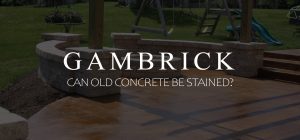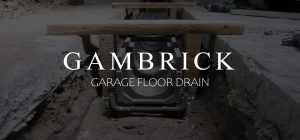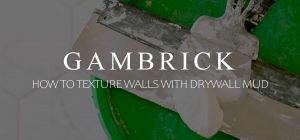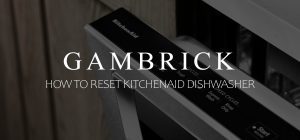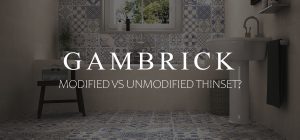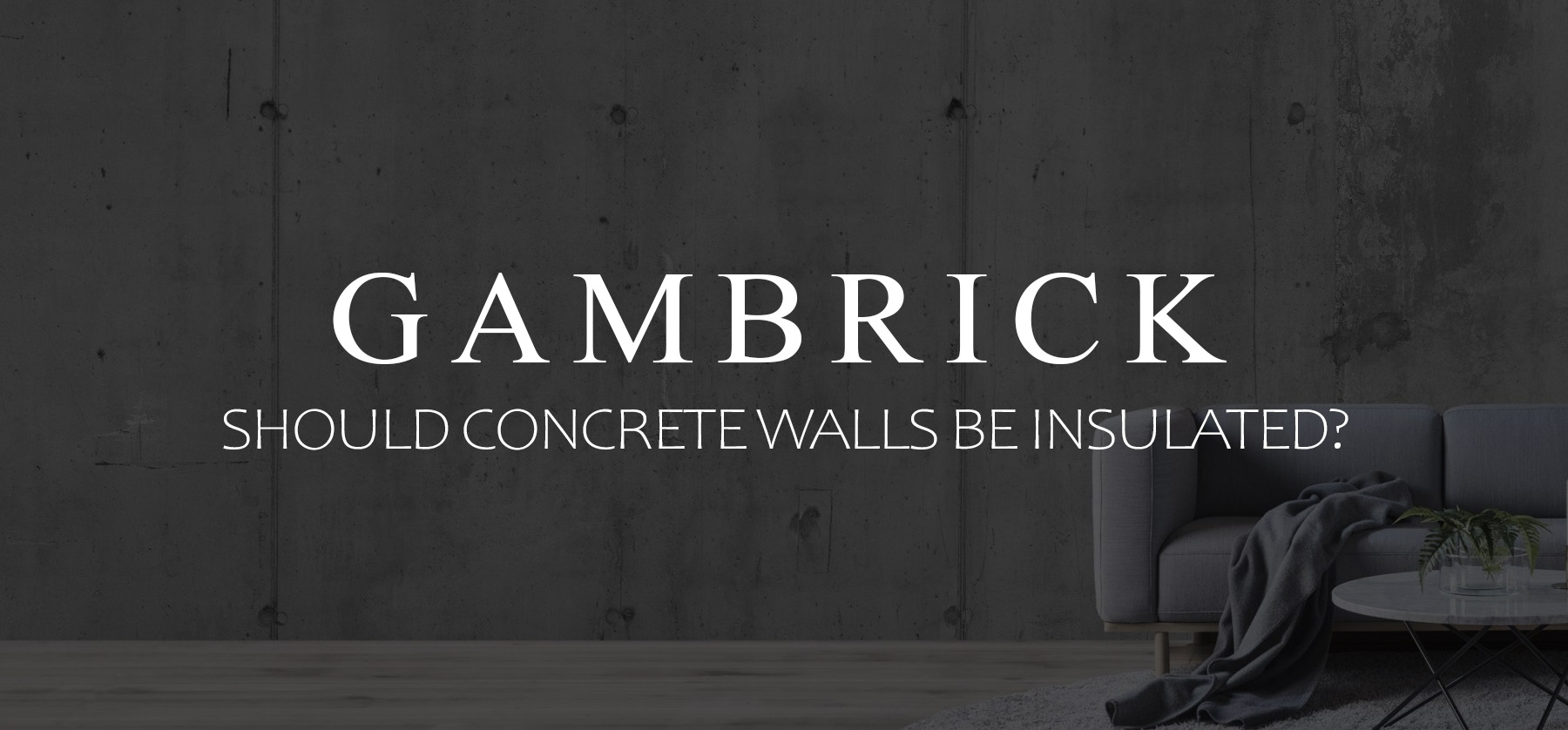
Should Concrete Walls Be Insulated?
Concrete is a fantastic material that’s been used for centuries to build homes around the world. It’s very strong, durable, resistant to the elements and easy to work with. But for all it’s strong points, concrete is a very poor insulator. Even a 12 inch thick solid concrete wall only has an R-value of around 2. That’s far less than most code requirements and definitely not energy efficient. So should concrete walls be insulated? In my opinion the answer is a big yes. It improves energy efficiency, makes a home more comfortable to live in, helps prevent mold and saves money on monthly energy bills. And best of all it’s not that hard or expensive to do.
While concrete is a very strong and reliable building material, it’s a terrible insulator. Hot and cold pass right through it. In the building industry we call materials like concrete a thermal bridge. Any heat inside the home will pass right through the concrete with very little resistance. This can cause expansion and contraction of the material and concrete cracks. The concrete acts as a sort of bridge for your heat to get outside. We eliminate the bridge and keep heat in by adding insulation.
In order to regulate the temperature of a living space, concrete needs to be insulated.
Ahead we’ll discuss the best ways to insulated a concrete wall and how to do it.
Benefits Of Insulating Concrete
When most people think of a solid concrete or block wall they picture a basement. But in many homes, concrete is used to build the first and second floor walls as well. It’s not as common here in the United Stated because we use more wood framing, but in other countries, especially Europe, they rely on concrete and masonry products. Insulating those concrete walls is even more important because that’s your primary living areas.
Below we’ll talk a bit about all the benefits of insulating concrete walls both in a basement and above grade.
Energy Efficiency
Energy efficient home building is something most people are concerned with these days. When a home is well insulated, it’s more comfortable to live in because the temperature doesn’t fluctuate as much. Less heating and cooling is needed to maintain temperature which means lower energy bills. There’s absolutely no drawback to insulating a concrete wall. Letting hot and cold pass through the walls without any control whatsoever does nothing for the home.
Anything that reduces the average required energy to perform a certain task is considered to be energy efficient. For example, if your heating bill is $400 a month and you insulate the concrete walls and now it’s $200 a month, that’s energy efficiency. Insulation is energy efficient because it lowers the amount of heating and cooling needed to regulate the temperature of your home.
Even if your concrete walls are only in the basement that still has an impact on the living space above. Cold can get into the basement and up through the floor since most basement ceilings aren’t well insulated. It’s important to not only insulated the block wall but also the ceiling around it. In general, insulating at least 2 foot around the edges of your basement ceiling in addition to the concrete walls is a good idea.
Mold Reduction
Although concrete may seem smooth and dense, it’s actually a very porous material. Because of all of these small pores, it can soak up water like a sponge. And in some cases water can work it’s way right through it. This is why insulation and vapor barriers are so important. Water will find its way into your concrete when given the chance.
Wet concrete in a dark and cold environment can eventually lead to mold growth.
Mold and mildew is a type of fungi that grows in wet, cold, and dark conditions. Concrete basements and garages are very susceptible to this issue. Once mold starts to grow in and on the concrete, it can quickly spread to inside the walls, ducts and throughout the home. Certain types of mold and mildew can even pose threats to your health if left untreated. Especially if it gets into the air.
Once mold starts to spread it can be hard to find and treat. It’s much better to stop mold from growing than it is to kill it later. It’s a living thing, so if you miss even a small portion it will continue to spread.
When concrete walls are sealed and insulated with a vapor barrier, it prevents water from absorbing into the concrete walls. If water can’t get in then mold can’t grow.
Spray foam is a great way to insulate concrete walls because it’s not only a great insulator but also water resistant. There are two kinds of spray foam insulation, closed-cell and open-cell. Closed-cell is better for concrete because it’s more water resistant.
Saves Money
Insulating concrete walls can reduce heating and cooling costs. What insulation does is help regulate the inside temperatures which is called conditioned space. The steadier your temperature in these spaces the less you have to use the heat or AC to regulate the temperature.
Lets say it’s 70 degrees on a beautiful spring day with no humidity. Since the outside air is the same as what most people want the inside air to be, you don’t need heat or AC to make the home comfortable.
But during winter months, when the air outside is 30 degree and you want it 70 degrees inside, that’s a difference of 40 degrees. Heat is needed to bring the home up to 70 degrees. But it’s the insulation that keeps it at that temperature. The more insulation you have the longer the home will stay at 70 degrees without needing more heat. This is called heat loss. Home’s with poor insulation have a lot of heat loss.
Outside air and the earth can get very cold. Due to concrete’s low R-value, the cold outside is easily transferred through the concrete and into the inside. This makes living spaces next to concrete walls feel cold. The same is true of heat. Without insulation, inside temperatures are either too hot or too cold to be comfortable.
If concrete walls are not insulated, you’ll have to spend a lot of money regulating inside temperatures up and down.
Insulating concrete walls can reduce the amount of heat transfer between the outside elements and the inside conditioned space by adding a layer of material with a much higher R-value. This layer of insulation stops heat loss and regulates temperature which saves money.
Best Insulation To Use With Concrete
Some types of insulation are better than other when used with concrete. Below we’ll discuss a few different kids and how to use them.
Closed-Cell Foam
If your insulating the interior of a concrete wall with spray foam, use closed-cell spray foam, not open-cell foam. Closed-cell foam is better at resisting moisture that can penetrate through the concrete. It acts as an additional vapor barrier that can help keep water out and prevent mold.
Frame the 2×4 wall with a gap of about 2 inches between the 2x4s and the concrete. Then fill the voids between studs and the 2 inch gap with foam.
If you live anywhere that’s cold your concrete basement walls should be insulated. In climate zones 3 and higher, basement insulation is required by the International Residential Code as follows:
- R-5 in climate zone .
- R-10 in climate zone 4 (except marine zone 4).
- R-15 in marine zone 4 and climate zones 5, 6, 7, and 8.
It’s much easier to install interior insulation against a concrete wall than exterior insulation because that typically requires excavation work. Also, if there’s ever a problem with the insulation, it’s easier to deal with from the inside rather than the outside because of excavation.
Rigid Foam
A 2 inch layer of XPS foam (R-10) is enough insulation in most of climate zone 4. However, if you live in marine zone 4 or in zones 5, 6, 7, or 8, you need at least 3 inches of XPS or 4 inches of EPS to meet the minimum code requirement of R-15.
Place the foam directly onto the concrete wall. Then, place wood furring strips onto the foam. Secure the strips to the concrete by drilling through the foam.
Drywall or some other type of wall board can then be secured to the wood furring strips.
Rigid foam is a good vapor barrier. For even more protection, caulk the seams and apply tape. This will keep out even more moisture and air flow.
Why Concrete Is Bad At Insulating
R-value is based on a material’s resistance to the transfer of heat through the materials. The higher the R-value, the more resistant it is to the transfer of heat or cold.
The R-value of concrete depends on the concrete mixture used and it’s thickness. In general, a solid concrete wall 12 inches thick only has an R-value of around 2. Compare that to rigid foam with has between a 3-4 R-value per inch. That means a foam wall 12 inches thick would have an R-value between 36 and 48. Foam insulation is about 20 times more energy efficient than concrete.
What concrete is really goo at it absorbing heat. Concrete that gets lots of sun absorbs the heat and releases it slowly. That’s why concrete floors are so great when paired with radiant heating. The floors heat up and stay warm for hours. This same concept is used outdoor to build heated concrete driveways and sidewalks. If concrete had a higher R-value it would prevent this absorption and transference of heat.
In general, low-density concrete has a higher R-value than high density concrete but the difference is very minimal.
Tips
- Make Sure The Basement Is Dry. Before installing any new wall insulation, make sure that your basement doesn’t have a water problems. Finding and fixing water issues before you insulate is very important because if you don’t, you’ll simply cover up the issue not fix it. If you want to fix the water problem later on you’ll have to rip out all the insulation.
- Keep Water Out. Some people believe that a damp concrete wall should be able to dry inward by using permeable insulation. This is wrong. You don’t want to allow any moisture to enter your home. Don’t worry about your concrete wall from inside, if it gets damp then it needs sealing from the outside.
- Avoid Polyethylene Vapor Barriers. Wall systems should never include polyethylene. You don’t need any poly between the concrete and the foam insulation, nor do you want poly between drywall and the insulation. Polyethylene can trap moisture, leading to mold or rot in wood.
- Insulation Is Cost-Effective. If you live in a cold climate, installing concrete wall insulation will almost always save you money through lower energy bills.
- Insulated walls are less susceptible to condensation and mold.
- Gaps. If your framing a stud wall you intend to insulate that’s sitting against a concrete wall, leave about 2 inches between the walls. Fill this gap with spray foam in addition to the void between studs. This creates a thermal break which stops heat loss. It’s also a great vapor barrier.
Summary: Should Concrete Walls Be Insulated?
Concrete is a fantastic material that’s been used for centuries to build homes around the world. It’s very strong, durable, resistant to the elements and easy to work with. But for all it’s strong points, concrete offers very low natural insulation levels. Even a 12 inch thick solid concrete wall only has an R-value of around 2. That’s far less than most code requirements and definitely not energy efficient. So should concrete walls be insulated? In my opinion the answer is a big yes. It improves energy efficiency, makes a home more comfortable to live in, helps prevent mold and saves money on monthly energy bills. And best of all it’s not that hard or expensive to do.
While concrete is a very strong and reliable building material, it’s a terrible insulator. Hot and cold pass right through it. In the building industry we call materials like concrete a thermal bridge. Any heat inside the home will pass right through the concrete with very little resistance. The concrete acts as a sort of bridge for your heat to get outside. We eliminate the bridge and keep heat in by adding insulation.
In order to regulate the temperature of a living space, concrete needs to be insulated.
If you have any questions or comments e-mail us any time. We’d love to hear from you.

John Mazzuca | About | More Posts |
Custom Home Builder
John Mazzuca is a custom home designer and builder at Gambrick with over 25 years experience in the construction industry. John has designed, built and/or remodeled hundreds of homes, small buildings, and commercial projects. He writes about business, real estate, home building, and household electronics. His work has been featured in Fox Business, Better Homes & Garden, House Beautiful, and more.

